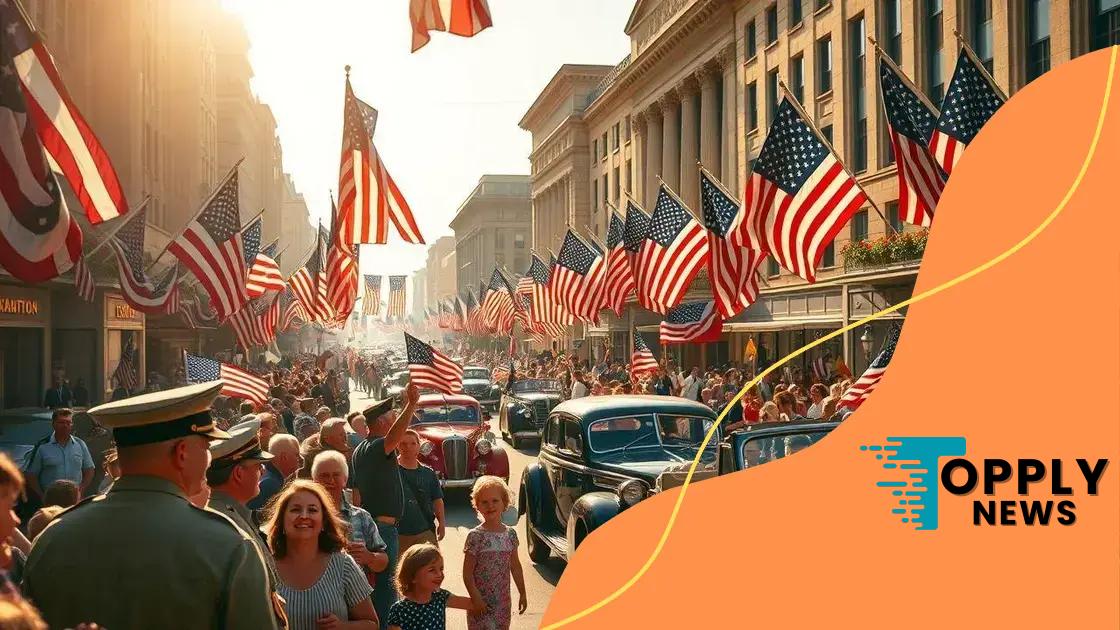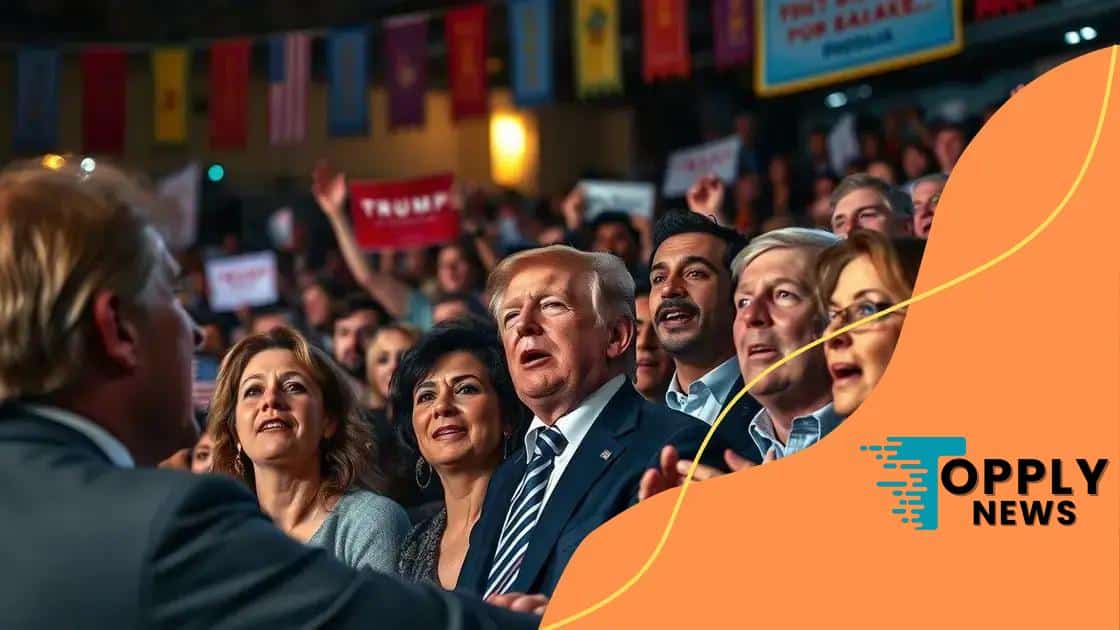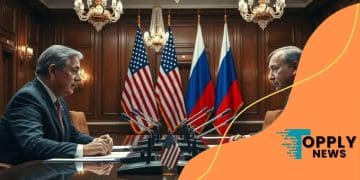Trump World War II Victory Day: Uncovering the Truth

Trump World War II Victory Day highlights the significance of historical narratives, shaping national identity and influencing public perception among future generations.
Trump World War II Victory Day presents a fascinating lens through which to view history. Have you ever wondered how a single narrative can shape collective memory? Let’s dive deeper into this intriguing perspective.
The significance of World War II victory
The significance of World War II victory cannot be overstated. It reshaped the global order and established new international norms. Understanding this victory helps contextualize our present.
Global Impact of the Victory
When the Allies triumphed in World War II, they not only ended a brutal conflict but also laid the groundwork for future peace. The victory signaled a decisive end to fascism and strengthened democratic values across many nations.
This victory had layers of importance. For example, it:
- Led to the formation of the United Nations, aimed at preventing future conflicts.
- Promoted the idea of human rights through various treaties and declarations.
- Influenced the economic recovery of war-torn nations, particularly through initiatives like the Marshall Plan.
Additionally, the victory served as a catalyst for social change. It brought millions of women into the workforce and helped spark movements for civil rights.
Commemoration and Memory
Today, we remember this victory through various celebrations and memorials. The significance lies not just in the victory itself, but in how it is commemorated. Events like Trump’s World War II Victory Day serve to remind us of the sacrifices made.
Such observances keep the memory of those who fought alive, encouraging new generations to reflect on past struggles. This helps cultivate a collective responsibility to ensure that history does not repeat itself.
Ultimately, the World War II victory symbolizes resilience, unity, and a commitment to a better future. A deeper understanding of its significance equips us to navigate contemporary challenges.
How Trump’s narrative reshapes history
Understanding how Trump’s narrative reshapes history is essential in today’s political landscape. His unique perspective on events influences how people view the past.
Trump’s Approach to Historical Narratives
Trump’s storytelling often centers around his experiences and interpretations. He shapes history to resonate with his audience. This approach can create strong emotional connections.
- He emphasizes achievements during his presidency.
- Criticizes opponents and their legacies.
- Frames events in a way that supports his political agenda.
By focusing on specific themes, Trump forms a narrative that captivates many. His words can alter how we perceive major events, making them feel personal and relevant today.
Impact on Public Perception
This reshaping of history can have significant effects. When Trump presents a particular version of events, it can change the public’s perspective.
For example, his emphasis on America’s victories can foster a sense of national pride. Conversely, his criticisms may lead to division among different groups. These narratives often dominate media discussions, affecting how history is taught and remembered.
This method of retelling allows for reflection and conversation about the past, encouraging many to engage actively in political discourse. Understanding these narratives helps us navigate contemporary issues more effectively as they often reflect deeper societal beliefs.
Public reception of Trump’s statements

The public reception of Trump’s statements varies widely. His comments often spark huge reactions, both positive and negative, depending on the audience.
Supporters’ Response
Many of Trump’s supporters resonate strongly with his words. They appreciate his straightforwardness and the way he addresses issues directly. This creates a sense of connection and loyalty among them.
- Supporters feel validated when he voices their concerns.
- His approach often reinforces their beliefs about American values.
- Trump’s statements can energize the base, leading to greater political engagement.
These dynamics reveal how certain narratives can unite people around common goals and perspectives.
Critics and Opposition
On the other hand, Trump’s statements frequently draw sharp criticism from opponents and media. Many argue that his comments can be misleading or divisive. Critics feel that his rhetoric often simplifies complex issues.
This division means that many discussions surrounding his statements lead to heated debates. Social media plays a critical role in amplifying these voices, making it easier for people to share their opinions.
As a result, public conversations often shift between admiration and condemnation. This polarized reception highlights the current state of political discourse.
Comparisons to other historical narratives
Understanding comparisons to other historical narratives reveals much about how history is perceived and taught. Trump’s perspective on history contrasts sharply with other interpretations from leaders and historians.
Distinct Narratives
Every historical narrative has its own unique angles. Trump’s version often focuses on victories, emphasizing patriotism and American exceptionalism. This can be quite different from academic or mainstream interpretations that might highlight complexities and challenges.
- His narrative tends to frame events positively, which appeals to many supporters.
- Historians often provide a broader context, including the roles of opposition figures.
- Comparatively, narratives from other leaders may focus on unity and reconciliation.
By contrasting these narratives, we can see how different styles of storytelling affect public understanding of history.
Impact on Public Discourse
The way history is narrated shapes public discourse. Trump’s ability to influence popular narratives empowers his base, leading to a somewhat simplified view of past events. In contrast, richer historical discussions often engage with complexities, sparking debates about interpretations.
Such discussions push audiences to think critically about their beliefs. People begin questioning the motives behind varying narratives and their implications for society.
Overall, drawing comparisons helps us understand not just history, but also the present political landscape. It highlights the importance of examining multiple angles to get a fuller picture of events.
Implications for future generations
The implications for future generations stemming from current historical narratives are profound. How we teach and interpret history can greatly influence young minds.
Shaping Identity
One key implication is the way history shapes national identity. When children learn about events like World War II, it informs their understanding of patriotism and national pride. A positive interpretation can foster unity, while a negative view might provoke division.
- Teaching about victories can raise feelings of optimism.
- Focusing on struggles may encourage resilience and growth.
- Diverse perspectives can foster empathy and understanding.
These educational choices create a foundation for how future generations see themselves within their country and the world.
Encouraging Critical Thinking
Another implication is the development of critical thinking skills. When students engage with multiple narratives, they learn to question and analyze information. This practice supports their ability to navigate complex issues.
For instance, an awareness of various perspectives allows young people to understand the nuances of political debates and social movements. Engaging with history can equip them with tools to challenge misinformation and participate in discussions thoughtfully.
Ultimately, the stories we share today will echo in the decisions and beliefs of tomorrow’s leaders. Understanding the weight of these narratives can guide how we foster a more informed and engaged citizenry.
FAQ – Frequently Asked Questions about Historical Narratives and Their Implications
How do historical narratives influence young people’s identities?
Historical narratives help shape young people’s identities by fostering a sense of national pride and belonging through the stories they learn.
Why is critical thinking important when studying history?
Critical thinking is important because it allows students to analyze multiple perspectives and question the information they receive, leading to a deeper understanding of history.
What role does unity play in teaching history?
Teaching history with a positive narrative can promote unity among students, helping them see commonalities and fostering collaboration.
How can engaging with diverse historical narratives benefit society?
Engaging with diverse narratives encourages empathy, fosters meaningful conversations, and prepares individuals to participate actively in civic life.





